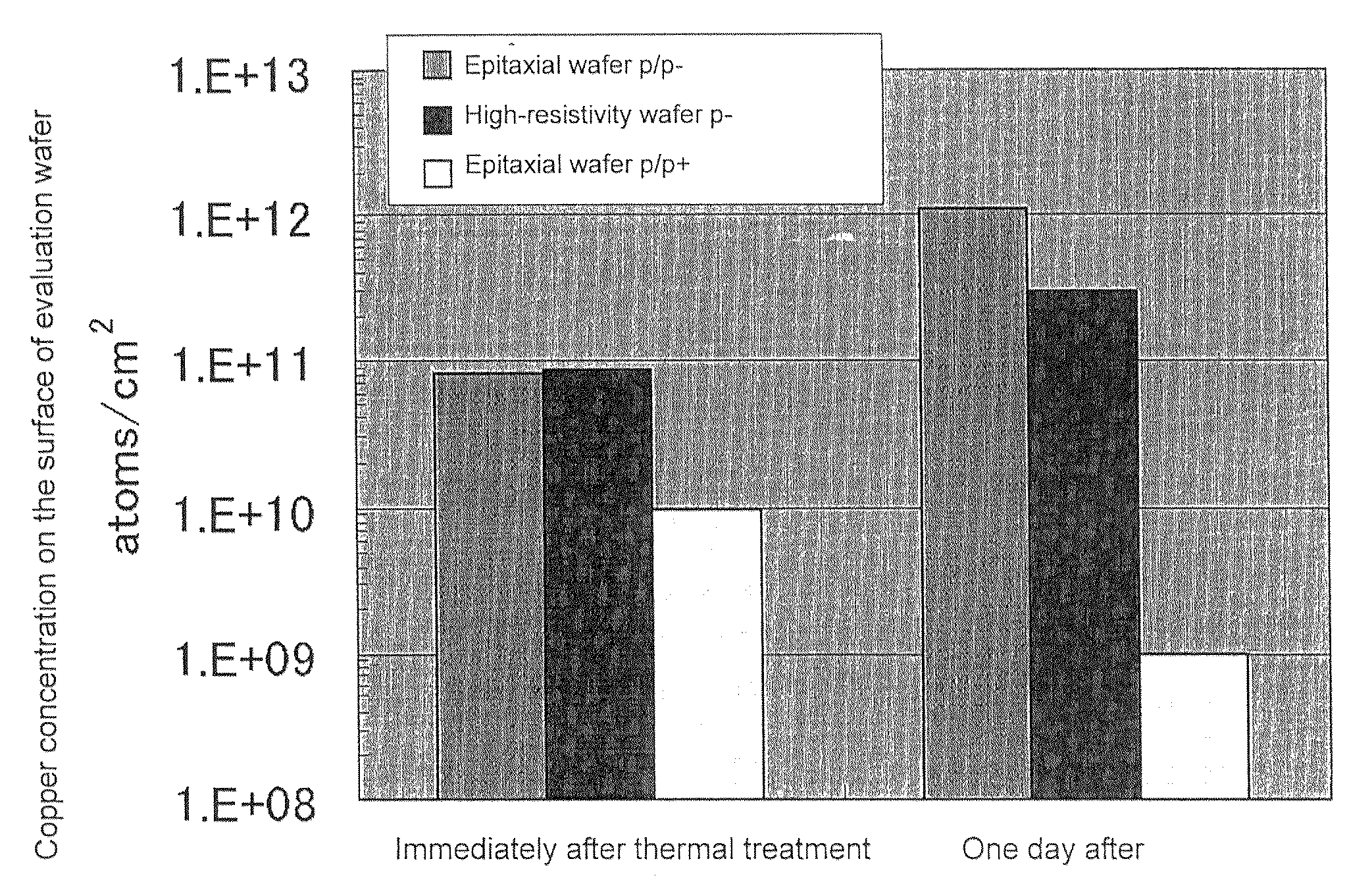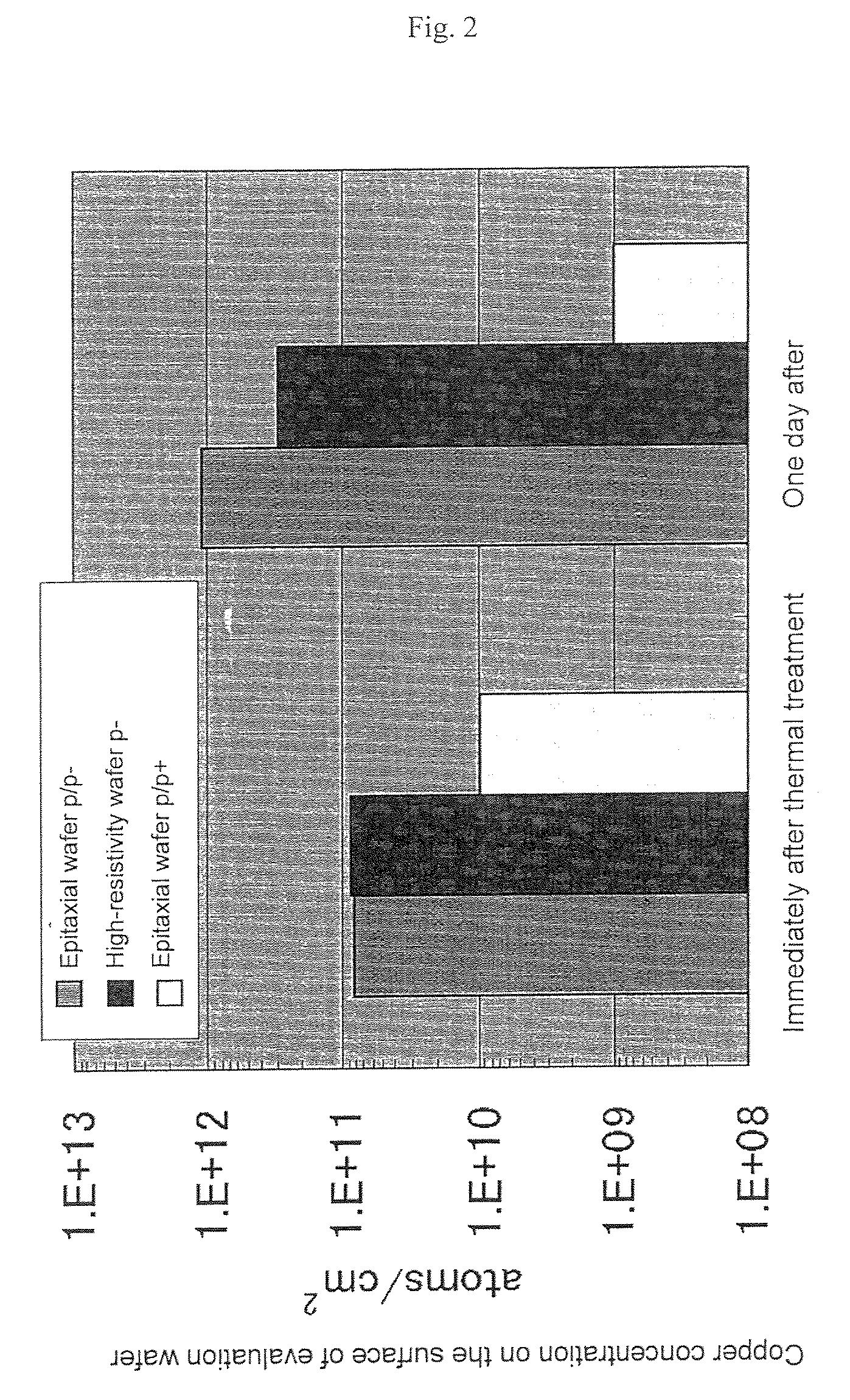Method of evaluating thermal treatment and method of manufacturing semiconductor wafer
a thermal treatment and semiconductor technology, applied in the direction of semiconductor/solid-state device testing/measurement, measurement devices, instruments, etc., can solve the problems of oxidation-induced stacking faults (osf), affecting device manufacturing yields, and device characteristics, and achieve convenient evaluating contamination and high sensitivity
- Summary
- Abstract
- Description
- Claims
- Application Information
AI Technical Summary
Benefits of technology
Problems solved by technology
Method used
Image
Examples
example 1
Manufacturing of a Wafer for Evaluating Thermal Treatment
[0075] A boron-doped epitaxial layer (thickness: 3 micrometers; resistivity: 6 ohms·cm) was deposited on a boron-doped silicon substrate (oxygen concentration: 1.0×1018 atoms / cm3 (ASTM F-121 1979), resistivity: 4 ohms·cm) to prepare an epitaxial wafer (p / p−) for evaluation of thermal treatment.
Evaluation of Nickel Collection Rate
[0076] The above wafer was contaminated to a known nickel contamination level of 1×1012 atoms / cm2 and heat treated to remove the surface oxide film. Subsequently, the nickel on the surface of the wafer was collected with an acidic collection solution (HF (2 weight percent) / H2O2 (2 weight percent) / H2O) and quantitatively analyzed by ICP-MS. Collection of the surface oxide film was conducted in the same manner as in Example 2 mentioned below.
[0077] As a comparative sample, the same treatment was conducted with a high-resistivity wafer (p−) and an epitaxial wafer (p / p+) having a substrate with low r...
example 2
Evaluation of Thermal Treatment Processes
(1) Analysis of Nickel
[0082] A boron-doped epitaxial layer (thickness: 3 micrometers; resistivity: 6 ohms·cm) was deposited on a boron-doped silicon substrate (oxygen concentration: 1.0×1018 atoms / cm3 (ASTM F-121 1979), resistivity: 4 ohms·cm) to prepare epitaxial wafers (p / p−) for evaluation of thermal treatment.
[0083] The above-described wafers for evaluation of thermal treatment were thermally treated under nitrogen atmospheres under one of the four conditions of 1 hour at 900 degrees Celsius, 10 hours at 900 degrees Celsius, 1 hour at 1,100 degrees Celsius, and 10 hours at 1,100 degrees Celsius in a heating furnace 1 employing a board treated with a CVD coating of SiC and a heating furnace 2 employing a board that had not been treated with a CVD coating of SiC.
[0084] Following thermal treatment, a hydrofluoric acid solution was introduced into a sealed container to remove the surface oxide films on the thermally treated wafers by va...
PUM
| Property | Measurement | Unit |
|---|---|---|
| thickness | aaaaa | aaaaa |
| resistivity | aaaaa | aaaaa |
| resistivity | aaaaa | aaaaa |
Abstract
Description
Claims
Application Information
 Login to View More
Login to View More - R&D
- Intellectual Property
- Life Sciences
- Materials
- Tech Scout
- Unparalleled Data Quality
- Higher Quality Content
- 60% Fewer Hallucinations
Browse by: Latest US Patents, China's latest patents, Technical Efficacy Thesaurus, Application Domain, Technology Topic, Popular Technical Reports.
© 2025 PatSnap. All rights reserved.Legal|Privacy policy|Modern Slavery Act Transparency Statement|Sitemap|About US| Contact US: help@patsnap.com



